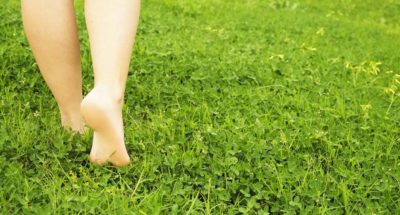
Barefoot Walk: A Mindful Movement Practice
Lead children in a mountain pose, invite them to simulate different animal movements—and to feel the sensations in their toes and feet as they walk.

Lead children in a mountain pose, invite them to simulate different animal movements—and to feel the sensations in their toes and feet as they walk.
Students will:
Lead your students through each of the activities below, concluding with the barefoot walk (“Take a hike”).
Stand barefoot on the ground in Mountain Pose. Firmly plant your feet into the ground, a foot’s distance apart, arms slightly out from your sides, palms facing forward. Take a deep breath in, feeling the breath rise up your feet all the way to your head. Slowly breathe out, releasing the breath through your mouth. [Repeat the full body breath 3 times.]Can you describe the sensations, temperatures, and textures you feel through your feet?
Let’s warm up for our walk by moving like different animals and insects. [Let the kids choose what they’d like to be, then follow their movements and sounds.]
Place your feet firmly on the ground, toes lifted. Now try placing each toe down slowly and separately starting with the pinkie. Is it easier to do on one foot versus the other? Try gripping the ground with your toes. What does it feel like?
Begin walking purposely. Use every surface of your foot, including your heel, instep, sole, ball of the foot, and each toe. Roll through each step, feeling the earth beneath your foot. Notice any shifts in energy.
Ask students: What is it like to notice your feet on the ground? How did it feel? What did you observe in your body as you slowed down each step?
Mindful Littles Barefoot Walking Activity. Mindful Littles is a 501(c)(3) nonprofit organization dedicated to sparking compassionate action in youth and in communities through engaging service learning experiences and mindful well-being programs that foster resiliency, prosocial behavior, and improved mental health.
Mindful walking is a foundational component of Mindfulness-based Stress Reduction for adults and many adapted mindfulness programs for youth. A 2014 meta-analysis that focuses on 24 mindfulness studies with K-12 students demonstrated changes in students’ attention and resilience to stress, including positive emotions, self-esteem, and self-concept.
Children face numerous daily stressors that can negatively affect their learning and development. Teaching students this practice may reduce their stress, bolster their personal well-being, and improve their attention and executive functions (e.g., self-control, planning, decision-making, etc.) as well as their school functioning.

Do you want to dive deeper into the science behind our GGIE practices? Enroll in one of our online courses for educators!
Comments